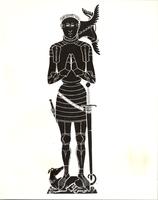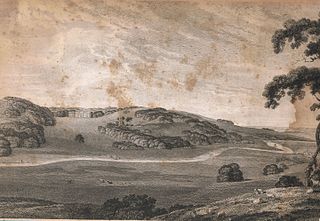

Sir John St Leger (died 1441) of Ulcombe in Kent, was Sheriff of Kent in 1430 and 1433. [2]


Sir John St Leger (died 1441) of Ulcombe in Kent, was Sheriff of Kent in 1430 and 1433. [2]
He was a son of Arnold St Leger, of Ulcombe, MP for Kent. [3]

He married Margery Danet, daughter and heiress of James Donet (died 1409) of Silham in the parish of Rainham, Kent, by whom he had children including:
He died in 1441 and was buried in the chapel of St Thomas the Martyr in the parish church of Ulcombe, as he requested in his will. His Latin will dated 12 December 1441 survives in the records of the Prerogative Court of Canterbury. [8]
A fragment of his monumental brass survives in Ulcombe Church, now displayed as a mural in the north aisle. The inscription is lost, but is said to have been: Here lyeth John Seintleger Esquyer, and Margerie his wyfe, sole daughter and heir of James Donnett ... 1442. [15] A rubbing showing the date 1442 survives in the collection of the Society of Antiquaries. [16]

Sir Anthony St Leger, KG, of Ulcombe and Leeds Castle in Kent, was an English politician and Lord Deputy of Ireland during the Tudor period.

Tamerton Foliot is a village and former civil parish situated in the north of Plymouth, in the Plymouth district, in the ceremonial county of Devon, England. It also lends its name to the ecclesiastical parish of the same name.

John Bourchier, 2nd Earl of Bath was an Earl in the peerage of England. He also succeeded to the titles of 12th Baron FitzWarin, Baron Daubeney and 4th Count of Eu.
Bowden is a historic estate in the parish of Yealmpton in Devon, England. From the 15th century until 1748 the manor house was for eight generations the seat of a junior branch of the Copleston family of Copplestone. The manor house was largely rebuilt in the 19th century and, together with some of its outbuildings, now serves as a farmhouse.

Baron FitzWarin was a title in the Peerage of England created by writ of summons for Fulk V FitzWarin in 1295. His family had been magnates for nearly a century, at least since 1205 when his grandfather Fulk III FitzWarin obtained Whittington Castle near Oswestry, which was their main residence and the seat of a marcher lordship.

Sir Thomas St LegerKB was the second son of Sir John St Leger (d.1441) of Ulcombe, Kent, and his wife, Margery Donnet. He was also the second husband of Anne of York, daughter of Richard Plantagenet, 3rd Duke of York and thus she was an elder sister of Kings Edward IV (1461–1483) and Richard III (1483–1485). His younger brother, Sir James St Leger of Annery in Devon, married Anne Butler, daughter of Thomas Butler, 7th Earl of Ormond, and was, therefore, an uncle to Thomas Boleyn, 1st Earl of Wiltshire.

Sir John St Leger, of Annery in Monkleigh, Devon, was an English landowner who served in local and national government.
Sir Warham St LegerPC (Ire) was an English soldier, administrator, and politician, who sat in the Irish House of Commons in the Parliament of 1585–1586.
John St Leger may refer to:

Monkleigh is a village, parish and former manor in north Devon, England, situated 2 1/2 miles north-west of Great Torrington and 3 1/2 miles south-east of Bideford. An electoral ward exists titled Monkleigh and Littleham. The population at the 2011 census was 1,488.

Annery was an historic estate in the parish of Monkleigh, North Devon.

The Manor of Monkleigh was a mediaeval manor centred on the village of Monkleigh in North Devon, England, situated 2 1/2 miles north-west of Great Torrington and 3 1/2 miles south-east of Bideford.

Joseph Prust (1620–1677) of Annery, in the parish of Monkleigh, Devon, was a royalist military commander during the Civil War. He was a lieutenant colonel.

William Bourchier (1407–1470) jure uxoris 9th Baron FitzWarin, was an English nobleman. He was summoned to Parliament in 1448 as Baron FitzWarin in right of his wife Thomasine Hankford.
The Manor of Shirwell was a manor in North Devon, England, centred on the village of Shirwell and largely co-terminous with the parish of Shirwell. It was for many centuries successively the seat of two of the leading families of North Devon, the Beaumonts and their heirs the Chichesters of Raleigh, Pilton, both of which families were seated at the estate of Youlston within the manor of Shirwell. The manor house which survives today known as Youlston Park is one of the most architecturally important historic houses in North Devon and exists largely in its Georgian form, but retains many impressive late 17th-century interiors.

Ash in the parish of Braunton in North Devon is a historic estate listed in the Domesday Book. The present mansion, known as The Ash Barton estate is a Grade II* listed building.

The historic manor of Tawstock was situated in North Devon, in the hundred of Fremington, 2 miles south of Barnstaple, England. According to Pole the feudal baron of Barnstaple Henry de Tracy made Tawstock his seat, apparently having abandoned Barnstaple Castle as the chief residence of the barony. Many of the historic lords of the manor are commemorated by monuments in St Peter's Church, the parish church of Tawstock which in the opinion of Pevsner contains "the best collection in the county apart from those in the cathedral", and in the opinion of Hoskins "contains the finest collection of monuments in Devon and one of the most notable in England".

Ralph St Leger of Ulcombe in Kent was Sheriff of Kent in 1467/8 and was constable of Leeds Castle in Kent. He was a member of the St Leger family.

Warleigh is an historic estate within the parish of Bickleigh in Devon, about 6 miles from Plymouth. Warleigh House, the manor house of the manor of Tamerton Foliot is situated one mile west of that village on the south-east bank of the River Tavy where it joins the River Tamar. It was remodelled in about 1830 in the Gothic style by John Foulston and has been listed Grade II* on the National Heritage List for England since 1960.

Philip Beaumont (1432–1473), lord of the manors of Shirwell in North Devon and of Gittisham in East Devon, was a member of parliament for a constituency in Devon and was Sheriff of Devon in 1469. He was the rightful heir of his elder brother William Beaumont (1427–1453), a substantial landholder, but faced claims to his inheritance from his bastard nephew, John Bodrugan, "The Beaumont Bastard", the illegitimate son of Joan Courtenay, William's wife.
{{cite book}}: CS1 maint: location missing publisher (link)